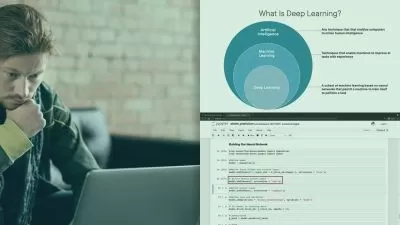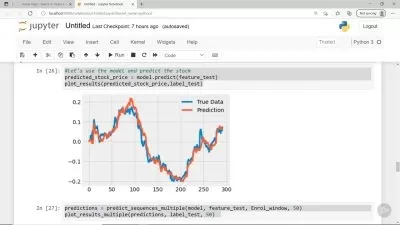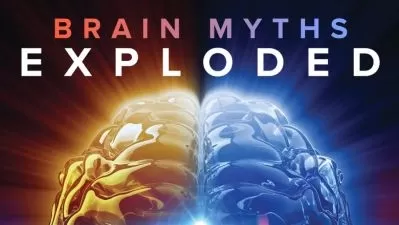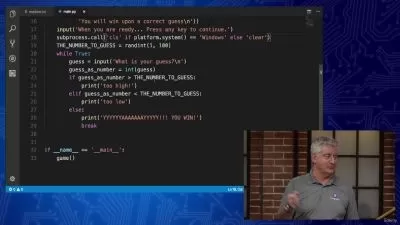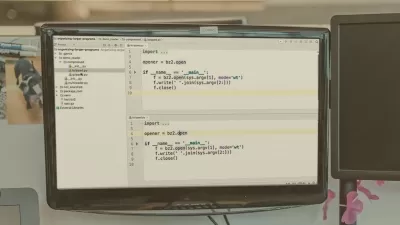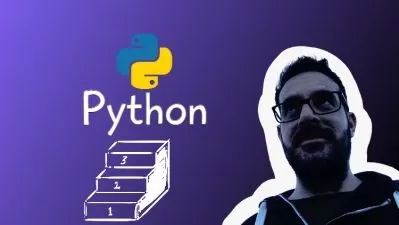Deep Learning: Neural Networks in Python using Case Studies
EDUCBA Bridging the Gap
6:17:38
Description
Learn how a neural network is built from basic building blocks using Python
What You'll Learn?
- Learn how a neural network is built from basic building blocks (the neuron)
- Learn how Deep Learning works
- Code a neural network from scratch in Python and numpy
- Describe different types of neural networks and the different types of problems they are used for
Who is this for?
What You Need to Know?
More details
DescriptionArtificial intelligence is growing exponentially. There is no doubt about that. Self-driving cars are clocking up millions of miles, IBM Watson is diagnosing patients better than armies of doctors and Google Deepmind's AlphaGo beat the World champion at Go - a game where intuition plays a key role. But the further AI advances, the more complex become the problems it needs to solve. And only Deep Learning can solve such complex problems and that's why it's at the heart of Artificial intelligence. Deep learning is increasingly dominating technology and has major implications for society. From self-driving cars to medical diagnoses, from face recognition to deep fakes, and from language translation to music generation, deep learning is spreading like wildfire throughout all areas of modern technology. But deep learning is not only about super-fancy, cutting-edge, highly sophisticated applications. Deep learning is increasingly becoming a standard tool in machine-learning, data science, and statistics. Deep learning is used by small startups for data mining and dimension reduction, by governments for detecting tax evasion, and by scientists for detecting patterns in their research data. Deep learning is now used in most areas of technology, business, and entertainment. And it's becoming more important every year.
Learn how Deep Learning works (not just some diagrams and magical black box code)
Learn how a neural network is built from basic building blocks (the neuron)
Code a neural network from scratch in Python and numpy
Code a neural network using Google's TensorFlow
Describe different types of neural networks and the different types of problems they are used for
Derive the backpropagation rule from first principles
Who this course is for:
- Students interested in machine learning - you'll get all the tidbits you need to do well in a neural networks course
- Professionals who want to use neural networks in their machine learning and data science pipeline. Be able to apply more powerful models, and know its drawbacks.
Artificial intelligence is growing exponentially. There is no doubt about that. Self-driving cars are clocking up millions of miles, IBM Watson is diagnosing patients better than armies of doctors and Google Deepmind's AlphaGo beat the World champion at Go - a game where intuition plays a key role. But the further AI advances, the more complex become the problems it needs to solve. And only Deep Learning can solve such complex problems and that's why it's at the heart of Artificial intelligence. Deep learning is increasingly dominating technology and has major implications for society. From self-driving cars to medical diagnoses, from face recognition to deep fakes, and from language translation to music generation, deep learning is spreading like wildfire throughout all areas of modern technology. But deep learning is not only about super-fancy, cutting-edge, highly sophisticated applications. Deep learning is increasingly becoming a standard tool in machine-learning, data science, and statistics. Deep learning is used by small startups for data mining and dimension reduction, by governments for detecting tax evasion, and by scientists for detecting patterns in their research data. Deep learning is now used in most areas of technology, business, and entertainment. And it's becoming more important every year.
Learn how Deep Learning works (not just some diagrams and magical black box code)
Learn how a neural network is built from basic building blocks (the neuron)
Code a neural network from scratch in Python and numpy
Code a neural network using Google's TensorFlow
Describe different types of neural networks and the different types of problems they are used for
Derive the backpropagation rule from first principles
Who this course is for:
- Students interested in machine learning - you'll get all the tidbits you need to do well in a neural networks course
- Professionals who want to use neural networks in their machine learning and data science pipeline. Be able to apply more powerful models, and know its drawbacks.
User Reviews
Rating
EDUCBA Bridging the Gap
Instructor's Courses
Udemy
View courses Udemy- language english
- Training sessions 51
- duration 6:17:38
- Release Date 2024/03/03






